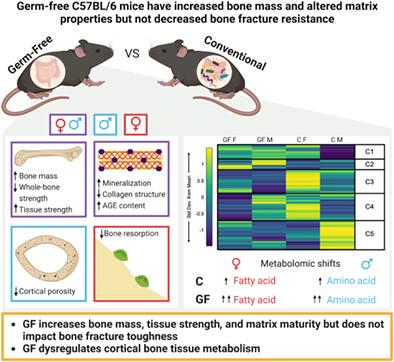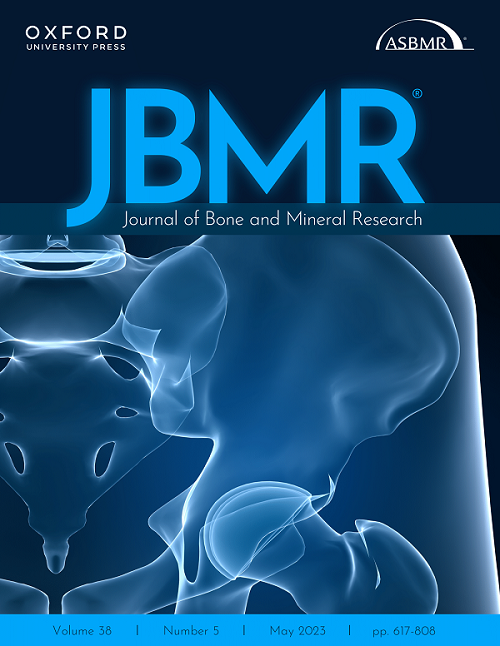Ghazal Vahidi, Maya Moody, Hope D. Welhaven, Leah Davidson, Taraneh Rezaee, Ramina Behzad, Lamya Karim, Barbara A. Roggenbeck, Seth T. Walk, Stephen A. Martin, Ronald K. June, Chelsea M. Heveran
下载PDF
{"title":"Germ-Free C57BL/6 Mice Have Increased Bone Mass and Altered Matrix Properties but Not Decreased Bone Fracture Resistance","authors":"Ghazal Vahidi, Maya Moody, Hope D. Welhaven, Leah Davidson, Taraneh Rezaee, Ramina Behzad, Lamya Karim, Barbara A. Roggenbeck, Seth T. Walk, Stephen A. Martin, Ronald K. June, Chelsea M. Heveran","doi":"10.1002/jbmr.4835","DOIUrl":null,"url":null,"abstract":"<p>The gut microbiome impacts bone mass, which implies a disruption to bone homeostasis. However, it is not yet clear how the gut microbiome affects the regulation of bone mass and bone quality. We hypothesized that germ-free (GF) mice have increased bone mass and decreased bone toughness compared with conventionally housed mice. We tested this hypothesis using adult (20- to 21-week-old) C57BL/6J GF and conventionally raised female and male mice (<i>n</i> = 6–10/group). Trabecular microarchitecture and cortical geometry were measured from micro–CT of the femur distal metaphysis and cortical midshaft. Whole-femur strength and estimated material properties were measured using three-point bending and notched fracture toughness. Bone matrix properties were measured for the cortical femur by quantitative back-scattered electron imaging and nanoindentation, and, for the humerus, by Raman spectroscopy and fluorescent advanced glycation end product (fAGE) assay. Shifts in cortical tissue metabolism were measured from the contralateral humerus. GF mice had reduced bone resorption, increased trabecular bone microarchitecture, increased tissue strength and decreased whole-bone strength that was not explained by differences in bone size, increased tissue mineralization and fAGEs, and altered collagen structure that did not decrease fracture toughness. We observed several sex differences in GF mice, most notably for bone tissue metabolism. Male GF mice had a greater signature of amino acid metabolism, and female GF mice had a greater signature of lipid metabolism, exceeding the metabolic sex differences of the conventional mice. Together, these data demonstrate that the GF state in C57BL/6J mice alters bone mass and matrix properties but does not decrease bone fracture resistance. © 2023 The Authors. <i>Journal of Bone and Mineral Research</i> published by Wiley Periodicals LLC on behalf of American Society for Bone and Mineral Research (ASBMR).</p>","PeriodicalId":185,"journal":{"name":"Journal of Bone and Mineral Research","volume":"38 8","pages":"1154-1174"},"PeriodicalIF":5.1000,"publicationDate":"2023-05-23","publicationTypes":"Journal Article","fieldsOfStudy":null,"isOpenAccess":false,"openAccessPdf":"https://onlinelibrary.wiley.com/doi/epdf/10.1002/jbmr.4835","citationCount":"0","resultStr":null,"platform":"Semanticscholar","paperid":null,"PeriodicalName":"Journal of Bone and Mineral Research","FirstCategoryId":"3","ListUrlMain":"https://onlinelibrary.wiley.com/doi/10.1002/jbmr.4835","RegionNum":1,"RegionCategory":"医学","ArticlePicture":[],"TitleCN":null,"AbstractTextCN":null,"PMCID":null,"EPubDate":"","PubModel":"","JCR":"Q1","JCRName":"ENDOCRINOLOGY & METABOLISM","Score":null,"Total":0}
引用次数: 0
引用
批量引用
Abstract
The gut microbiome impacts bone mass, which implies a disruption to bone homeostasis. However, it is not yet clear how the gut microbiome affects the regulation of bone mass and bone quality. We hypothesized that germ-free (GF) mice have increased bone mass and decreased bone toughness compared with conventionally housed mice. We tested this hypothesis using adult (20- to 21-week-old) C57BL/6J GF and conventionally raised female and male mice (n = 6–10/group). Trabecular microarchitecture and cortical geometry were measured from micro–CT of the femur distal metaphysis and cortical midshaft. Whole-femur strength and estimated material properties were measured using three-point bending and notched fracture toughness. Bone matrix properties were measured for the cortical femur by quantitative back-scattered electron imaging and nanoindentation, and, for the humerus, by Raman spectroscopy and fluorescent advanced glycation end product (fAGE) assay. Shifts in cortical tissue metabolism were measured from the contralateral humerus. GF mice had reduced bone resorption, increased trabecular bone microarchitecture, increased tissue strength and decreased whole-bone strength that was not explained by differences in bone size, increased tissue mineralization and fAGEs, and altered collagen structure that did not decrease fracture toughness. We observed several sex differences in GF mice, most notably for bone tissue metabolism. Male GF mice had a greater signature of amino acid metabolism, and female GF mice had a greater signature of lipid metabolism, exceeding the metabolic sex differences of the conventional mice. Together, these data demonstrate that the GF state in C57BL/6J mice alters bone mass and matrix properties but does not decrease bone fracture resistance. © 2023 The Authors. Journal of Bone and Mineral Research published by Wiley Periodicals LLC on behalf of American Society for Bone and Mineral Research (ASBMR).
无菌C57BL/6小鼠骨量增加,基质特性改变,但抗骨折能力不降低
肠道微生物群影响骨量,这意味着骨骼稳态的破坏。然而,目前尚不清楚肠道微生物群如何影响骨量和骨质量的调节。我们假设,与常规饲养的小鼠相比,无菌(GF)小鼠骨量增加,骨韧性降低。我们用成年(20- 21周龄)C57BL/6J GF和常规饲养的雌性和雄性小鼠(n = 6-10 /组)验证了这一假设。通过股骨远端干骺端和皮质中轴的显微ct测量骨小梁微结构和皮质几何形状。采用三点弯曲和缺口断裂韧性测量全股骨强度和估计材料性能。通过定量背散射电子成像和纳米压痕技术测量股骨皮质骨基质的性质,通过拉曼光谱和荧光晚期糖基化终产物(fAGE)测定肱骨骨基质的性质。从对侧肱骨测量皮质组织代谢的变化。GF小鼠骨吸收减少,骨小梁微结构增加,组织强度增加,全骨强度下降,这不是由骨大小的差异来解释的,组织矿化和fAGEs增加,胶原结构改变,但不降低断裂韧性。我们观察到GF小鼠的一些性别差异,最明显的是骨组织代谢。雄性GF小鼠具有更大的氨基酸代谢特征,雌性GF小鼠具有更大的脂质代谢特征,超过了常规小鼠的代谢性别差异。综上所述,这些数据表明,C57BL/6J小鼠的GF状态改变了骨量和基质特性,但不降低骨折抗力。©2023作者。由Wiley期刊有限责任公司代表美国骨与矿物研究协会(ASBMR)出版的骨与矿物研究杂志。
本文章由计算机程序翻译,如有差异,请以英文原文为准。


 求助内容:
求助内容: 应助结果提醒方式:
应助结果提醒方式:


